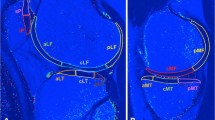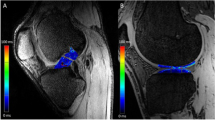Abstract
Objectives
To evaluate the changes in the mean T2 values of articular cartilage on serial follow-up images up to 1 year in patients who underwent lateral meniscus allograft transplantation (MAT).
Methods
Fifty-two patients who underwent lateral MAT surgery at our hospital were evaluated preoperatively and at 2 days, 6 weeks, 3 months, 6 months, and 1 year after MAT using 3.0-T magnetic resonance imaging (MRI) that included T2 mapping. T2 value changes according to the arthroscopic grading of chondromalacia were evaluated in the lateral and medial compartment. Lysholm scores were obtained pre- and postoperatively.
Results
The T2 values of cartilage were significantly increased 2 days after operation, and then gradually reduced to the baseline level after 1 year in both compartments. In morphologic assessment performed after 1 year, most areas (92.9 %) showed no interval change of chondromalacia grade. Lyshom knee scores increased significantly from the mean preoperative value of 62.5 (range, 23–95) to 89.7 (range, 64–100) at 1 year (p < 0.001).
Conclusion
Mean T2 values of cartilage following MAT exhibited a return to baseline level after 1 year. T2 measurement can be a useful tool for quantitative evaluation of postoperative cartilage changes compared to conventional MRI.
Key Points
• T2 mapping provides objective data for longitudinal monitoring following surgery.
• Increased cartilage T2 values post-MAT returned to baseline in one year.
• Further studies are required to predict the chondroprotective effect of MAT.




Similar content being viewed by others
References
Sekiya JK, Ellingson CI (2006) Meniscal allograft transplantation. J Am Acad Orthop Surg 14:164–174
Rijk PC (2004) Meniscal allograft transplantation—part I: background, results, graft selection and preservation, and surgical considerations. Arthroscopy 20:728–743
Verdonk PC, Verstraete KL, Almqvist KF et al (2006) Meniscal allograft transplantation: long-term clinical results with radiological and magnetic resonance imaging correlations. Knee Surg Sports Traumatol Arthrosc 14:694–706
Wirth CJ, Peters G, Milachowski KA, Weismeier KG, Kohn D (2002) Long-term results of meniscal allograft transplantation. Am J Sports Med 30:174–181
Lubowitz JH, Verdonk PCM, Reid JB III, Verdonk R (2007) Meniscus allograft transplantation: a current concepts review. Knee Surg Sports Traumatol Arthrosc 15:476–492
Lee B-S, Kim J-M, Sohn D-W, Bin S-I (2013) Review of meniscal allograft transplantation focusing on long-term results and evaluation methods. Knee Surg Relat Res 25:1–6
Alparslan L, Winalski CS, Boutin RD, Minas T (2001) Postoperative magnetic resonance imaging of articular cartilage repair. Semin Musculoskelet Radiol 5:345–363
Verstraete KL, Verdonk R, Lootens T, Verstraete P, De Rooy J, Kunnen M (1997) Current status and imaging of allograft meniscal transplantation. Eur J Radiol 26:16–22
Lee BS, Chung JW, Kim JM, Cho WJ, Kim KA, Bin SI (2012) Morphologic changes in fresh-frozen meniscus allografts over 1 year: a prospective magnetic resonance imaging study on the width and thickness of transplants. Am J Sports Med 40:1384–1391
Lee DH, Kim TH, Lee SH, Kim CW, Kim JM, Bin SI (2008) Evaluation of meniscus allograft transplantation with serial magnetic resonance imaging during the first postoperative year: focus on graft extrusion. Arthroscopy 24:1115–1121
Trattnig S, Millington SA, Szomolanyi P, Marlovits S (2007) MR imaging of osteochondral grafts and autologous chondrocyte implantation. Eur Radiol 17:103–118
Horng A, Raya JG, Stockinger M et al (2015) Topographic deformation patterns of knee cartilage after exercises with high knee flexion: an in vivo 3D MRI study using voxel-based analysis at 3T. Eur Radiol 25:1731–1741
Disler DG, McCauley TR, Wirth CR, Fuchs MD (1995) Detection of knee hyaline cartilage defects using fat-suppressed three-dimensional spoiled gradient-echo MR imaging: comparison with standard MR imaging and correlation with arthroscopy. AJR Am J Roentgenol 165:377–382
Kijowski R, Blankenbaker DG, Munoz Del Rio A, Baer GS, Graf BK (2013) Evaluation of the articular cartilage of the knee joint: value of adding a T2 mapping sequence to a routine MR imaging protocol. Radiology 267:503–513
Rubenstein JD, Li JG, Majumdar S, Henkelman RM (1997) Image resolution and signal-to-noise ratio requirements for MR imaging of degenerative cartilage. AJR Am J Roentgenol 169:1089–1096
Cha JG, Yi JS, Han JK, Lee YK (2015) Comparison of Quantitative Cartilage T2 Measurements and Qualitative MR Imaging between Professional Ballet Dancers and Healthy Volunteers. Radiology 276:199–206
Link TM, Stahl R, Woertler K (2007) Cartilage imaging: motivation, techniques, current and future significance. Eur Radiol 17:1135–1146
Kim HK, Laor T, Graham TB et al (2010) T2 relaxation time changes in distal femoral articular cartilage in children with juvenile idiopathic arthritis: a 3-year longitudinal study. AJR Am J Roentgenol 195:1021–1025
Mosher TJ, Dardzinski BJ (2004) Cartilage MRI T2 relaxation time mapping: overview and applications. Semin Musculoskelet Radiol 8:355–368
Welsch GH, Mamisch TC, Domayer SE et al (2008) Cartilage T2 assessment at 3-T MR imaging: in vivo differentiation of normal hyaline cartilage from reparative tissue after two cartilage repair procedures--initial experience. Radiology 247:154–161
Welsch GH, Mamisch TC, Quirbach S, Zak L, Marlovits S, Trattnig S (2009) Evaluation and comparison of cartilage repair tissue of the patella and medial femoral condyle by using morphological MRI and biochemical zonal T2 mapping. Eur Radiol 19:1253–1262
Crema MD, Roemer FW, Marra MD et al (2011) Articular cartilage in the knee: current MR imaging techniques and applications in clinical practice and research. Radiographics 31:37–61
Mamisch TC, Trattnig S, Quirbach S, Marlovits S, White LM, Welsch GH (2010) Quantitative T2 mapping of knee cartilage: differentiation of healthy control cartilage and cartilage repair tissue in the knee with unloading--initial results. Radiology 254:818–826
Nardo L, Carballido-Gamio J, Tang S, Lai A, Krug R (2016) Quantitative assessment of morphology, T, and T of shoulder cartilage using MRI. Eur Radiol. doi:10.1007/s00330-016-4322-6
Juras V, Bohndorf K, Heule R et al (2015) A comparison of multi-echo spin-echo and triple-echo steady-state T2 mapping for in vivo evaluation of articular cartilage. Eur Radiol. doi:10.1007/s00330-015-3979-6
Raya JG, Dietrich O, Horng A, Weber J, Reiser MF, Glaser C (2010) T2 measurement in articular cartilage: impact of the fitting method on accuracy and precision at low SNR. Magn Reson Med 63:181–193
Curl WW, Krome J, Gordon ES, Rushing J, Smith BP, Poehling GG (1997) Cartilage injuries: a review of 31,516 knee arthroscopies. Arthroscopy 13:456–460
Mandelbaum BR, Browne JE, Fu F et al (1998) Articular cartilage lesions of the knee. Am J Sports Med 26:853–861
Wright RW (2009) Knee injury outcomes measures. J Am Acad Orthop Surg 17:31–39
Laird NM, Ware JH (1982) Random-effects models for longitudinal data. Biometrics 38:963–974
Büsing KA, Kilian AK, Schaible T, Debus A, Weiss C, Neff KW (2008) Reliability and Validity of MR Image Lung Volume Measurement in Fetuses with Congenital Diaphragmatic Hernia and in Vitro Lung Models 1. Radiology 246:553–561
Smith NA, MacKay N, Costa M, Spalding T (2015) Meniscal allograft transplantation in a symptomatic meniscal deficient knee: a systematic review. Knee Surg Sports Traumatol Arthrosc 23:270–279
Milachowski KA, Weismeier K, Wirth CJ (1989) Homologous meniscus transplantation. Int Orthop 13:1–11
Vanwanseele B, Lucchinetti E, Stussi E (2002) The effects of immobilization on the characteristics of articular cartilage: current concepts and future directions. Osteoarthritis Cartil 10:408–419
Rubenstein JD, Kim JK, Henkelman RM (1996) Effects of compression and recovery on bovine articular cartilage: appearance on MR images. Radiology 201:843–850
Subburaj K, Kumar D, Souza RB et al (2012) The acute effect of running on knee articular cartilage and meniscus magnetic resonance relaxation times in young healthy adults. Am J Sports Med 40:2134–2141
Lusse S, Claassen H, Gehrke T et al (2000) Evaluation of water content by spatially resolved transverse relaxation times of human articular cartilage. Magn Reson Imaging 18:423–430
Dunn TC, Lu Y, Jin H, Ries MD, Majumdar S (2004) T2 relaxation time of cartilage at MR imaging: comparison with severity of knee osteoarthritis. Radiology 232:592–598
Nickinson R, Darrah C, Donell S (2010) Accuracy of clinical diagnosis in patients undergoing knee arthroscopy. Int Orthop 34:39–44
Acknowledgments
The scientific guarantor of this publication is Sang Hoon Lee, professor at the Asan Medical Center. The authors of this manuscript declare no relationships with any companies, whose products or services may be related to the subject matter of the article. The authors state that this work has not received any funding. No complex statistical methods were necessary for this paper. Institutional Review Board approval was obtained. Written informed consent was waived by the Institutional Review Board.
Methodology: retrospective, observational study, performed at one institution.
Author information
Authors and Affiliations
Corresponding author
Electronic supplementary material
Below is the link to the electronic supplementary material.
ESM 1
(DOCX 364 kb)
Rights and permissions
About this article
Cite this article
Park, SY., Lee, S.H., Lee, M.H. et al. Changes in the T2 value of cartilage after meniscus transplantation over 1 year. Eur Radiol 27, 1496–1504 (2017). https://doi.org/10.1007/s00330-016-4497-x
Received:
Revised:
Accepted:
Published:
Issue Date:
DOI: https://doi.org/10.1007/s00330-016-4497-x




